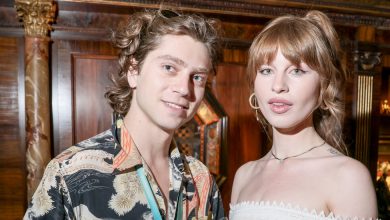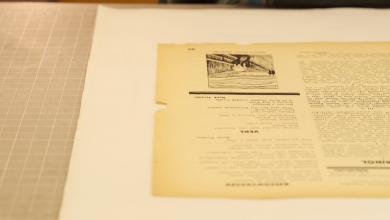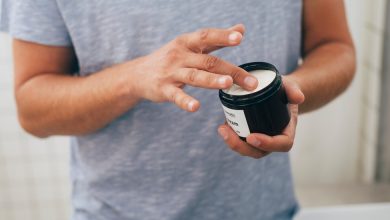Ja’Tovia Gary Sets Her Sights on Love

“I’m really excited to return to the garden and see what it brings,” says the conceptual artist Ja’Tovia Gary, 39. The garden in question is “The Giverny Suite” (2019), her densely layered three-channel video installation that will be on view at the Museum of Modern Art in New York, as a new addition to its collection, starting Sept. 1. In one of the suite’s segments, Gary visits Claude Monet’s garden at Giverny, in the Normandy region of France, staging herself as an errant presence within its manufactured perfection; as she roams the grounds, she suddenly disappears amid precisely arranged trees, and abruptly starts screaming by the water lily pond, inserting glitches into the image. Elsewhere in the suite, Gary treats a street corner in Harlem like its own discrete ecosystem, paying close attention to how Black women inhabit the space. “The Giverny Suite,” much like her practice in general, traverses geographies and histories while employing an array of experimental techniques. Yet the installation also coheres around a singular vision — one of autonomy and safety for Black women.
Gary’s films and multimedia pieces incorporate archival and digital materials, such as hand-painted 16 millimeter film strips and video clips from social media. They’ve been shown in galleries, museums and cinematic venues; her latest, “Quiet as It’s Kept” (2023), had its film festival premiere this summer at BlackStar in Philadelphia. A response to Toni Morrison’s debut novel, “The Bluest Eye” (1970), the film meditates on how Black women negotiate intimacy with one another. In addition to Morrison, “Quiet as It’s Kept”features the musician Azealia Banks; the Haitian American dancer Bianca Melidor; the scholar Dr. Kokahvah Zauditu-Selassie, who is also a priest of the Lukumi and Yoruba deity Obatala; Gary herself; and others in a set of interviews, reflections and performances.
Across multiple artworks, Gary is rigorous about citing her sources: She titled her first exhibition at Paula Cooper Gallery, in 2020, “Flesh That Needs to Be Loved,” after a line from Morrison’s “Beloved” (1987), and the author is quoted along with the writers Zora Neale Hurston and Saidiya Hartman in Gary’s “Citational Ethics,” a series of neon-lit sculptures. Gary is committed, in both her practice and her life, to returning to her roots. After many years in New York, where she pursued an M.F.A. in social documentary filmmaking at the School of Visual Arts, Gary has moved back to her birthplace, Dallas. She is now regrounding herself in the storytelling lineage of the Black South. “There’s such a thing as the fugitive narrative,” she says, referring both to the records of enslaved people and, more broadly, to accounts that counteract dominant understandings of the world. In her speech as in her art making, she intentionally repeats herself. Her ritualistic approach to memory brings to mind Morrison’s definition of the word: “willed creation.”
Gary keeps several altars in her work space and sits with them daily. She has also become an avid reader of romance novels, which she keeps stacked around her studio. She rejects calling them guilty pleasures. “I’m definitely fixing my sights — not just in a creative or professional sense but also in a personal sense — on love, in really trying to be heart centered and spirit led,” she says. Gary also takes seriously the tensions of desire and power that exist in those novels. She’s now considering experimenting with the romance genre in her own films.
Yet tenderness and yearning were already present in her practice. In a pivotal clip from “The Giverny Suite,” Nina Simone muses on the anguishes of love during her spellbinding performance at the 1976 Montreux Jazz Festival. “Care” and “ethics” are also recurring words in Gary’s oeuvre. In the segment of “The Giverny Suite” that’s filmed in Harlem, at the corner of West 116th Street and Malcolm X Boulevard, the artist asks a series of Black women and girls, “Do you feel safe?” The answers are as comforting as they are painful. Gary often seems ambivalent about the idea that exposure and visibility can ensure safety for any of them. She does not cede to the demand that, in order to exist or to be protected, everything about Black women should be legible or audible. Quiet as it must be kept.
What is your day like? How much do you sleep, and what’s your work schedule?
I have a pretty intense morning routine. And I’ll feel off, psychologically or even physically, if that routine doesn’t get done. Usually, I go to bed around 12 a.m. and wake up around 7 or 7:30. I read a little bit and then get up and make my bed. I’ve been listening over and over again to a six-hour gospel music playlist that I compiled at the end of last year. It’s mostly music [in the Black Southern tradition] from my childhood, from the ’90s, but there are also things from the ’80s and ’70s and a few contemporary hits. I do a little bit of Pilates. And then I sit at one of the altars I have set up in my space. Sometimes I go to the gym in the morning; other times, I go in the evening. After that morning routine, things vary depending on the day. Two or three times a week, I have what I call play time: I’ll pull out film strips and do a little etching and painting on the film, or I might work on a painting.
How many hours of creative work do you think you do in a day?
That varies as well. It depends on what we determine creative work to be, because reading can be creative, research can be creative. Sure, I’ve made this demarcation of what I call play time. But I feel like sitting at the altar is also a creative expression.
Do you think of creativity as simply part of your life practice, rather than something divided into hours of work?
I was going to say [my creative work starts] from the moment I wake up, but even dreaming is creative. I have such crazy dreams all the time and when I wake up, I’ll grab my phone to do a quick voice note. I don’t feel like there’s a separation: am I not being creative when I’m on the mat during Pilates? Am I not being creative when I’m making myself lunch?
What’s the worst studio you ever had?
My studio and where I live have almost always been the same place, and that makes it hard for me to name one “the worst.” An Instagram story recently brought me back to 258 weeks ago, when I was still living in Brooklyn. I was looking at my old apartment and how cramped it was. There were boxes everywhere, a bunch of film reels on the sofa. The sofa was really cheap. And I really loved that apartment. It was $1,600, in Bed-Stuy, one bedroom, maybe 800 square feet. But it had nothing in it, because I was broke. I would do my work at the kitchen table. I wouldn’t say that this was my worst studio, but it was a humble beginning and supergenerative, superfecund. And it reminds me that you can start where you are with what you have, and do what you can.
What’s the first work you ever sold? For how much?
The first work I ever sold was “An Ecstatic Experience” (2015). The Whitney Museum was my first placement in 2015 or 2016. Isn’t that crazy? Shout out to [the curator] Chrissie Iles. I was thinking, “I’m young, I haven’t sold anything before this.” I was asking around for advice, but I needed that money, so I sold it for well under $10,000. I lowballed myself, but that was in 2016 and by the time I got to the galleries in 2018, those prices had substantially increased.
When you start a new piece, where do you begin — in other words, what’s the first step?
I begin by writing down notes. I might be listening to a talk, or revisiting a book or thinking through an essay that someone wrote, so that I can begin to formulate an argument and sense the tension there. Sometimes I’m just scribbling on a napkin, but I also have a series of notebooks, each associated with different projects. A new piece comes from an idea, and it usually also comes from a feeling. The feeling is not disconnected from the idea.
How do you know when you’re done?
It’s very instinctual. A kind of gut reaction. The piece is done when it’s no longer just a series of disparate elements that I’m trying to fit together, but it’s this living, breathing thing that is talking back to me. Am I able to understand it? Is it clear? You need to back off when it tells you to because you don’t want to overwork it, or you risk losing coherence and concision, and the purity of the thing. You don’t want it to turn into rubber, like a rubbery piece of shrimp.
Have you assisted other artists before? If so, who?
I did a lot of assistant editing and archival assistant work, not within the art world, more so in the documentary film world. I worked with a woman named Judy Aley, who was the archival producer for “Free Angela And All Political Prisoners” (2012) [about the activist Angela Davis]. After that, she brought me on to the Spike Lee’s documentary [about Michael Jackson’s 1987 album] “Bad 25” (2012). And then a wonderful Black editor who passed away a few years ago — may he rest in peace — named Lewis Erskine, who won an Emmy for “Freedom Riders” (2010) [a documentary about the Civil Rights Movement], got me on board at Ken Burns’s shop, for “Jackie Robinson”(2016). I went to film school, so a lot of my apprenticeship was in that space.
What music do you play when you’re making art?
We’ve already talked about the gospel. I’ve got another playlist called “Goddess Worship,” and it’s nothing but Black women singers, from all genres and all time periods. So you might go from Nina Simone to TLC to Whitney Houston to Ella Fitzgerald to Odetta to Megan Thee Stallion. I really love Alice Coltrane and the kind of esoteric Black jazz tradition that mixes in musical elements associated with Eastern philosophy or religious practices. Also, Pharoah Sanders, Don Cherry — something instrumental that is also dynamic and expansive, that allows my mind to float while doing something tactile.
When did you first feel comfortable saying you’re a professional artist?
Well, I’ve never said I’m a professional artist, but I’ve always been an artist, since I was a little girl. That’s one of the things I’m most proud of: I never let go of my claim on being an artist. Most children are artists. They’re out of the womb drawing, painting, performing, doing little skits, dancing. But as the thing goes, when you get older, you lose that creative freedom or it’s stripped from you — because of the conditions under which we live. Capitalism, patriarchy.
Are you bingeing on any shows right now?
The last one that I think I got caught up in was the second or third season of “Ted Lasso.” But for the past several months I haven’t been watching a ton of TV. I do binge on romance novels, even though they’re not taken seriously. I’m coming out of the closet with it! I read these book series about Black folks falling in love and working through their emotional lives and their past wounds. To me, this is research because I am interested in the genre of romantic drama in filmmaking.
What’s the weirdest object in your studio?
A box of vintage baby shoes. I know. I think I’m going use them for a sculpture.
How often do you talk to other artists?
Oh, almost all the time! Four or five times a week — I started this practice during the pandemic — I’m voice messaging with friends. We might leave some elaborate, long, even nine-minute voice message in which we go through an emotional roller coaster. We might start off singing, or complaining or asking questions. We’re dropping the name of a book or something that we’ve seen or listened to; we’re usually putting each other on. These people are my community and they don’t really live close by, but those exchanges are so rich.
What do you do when you’re procrastinating?
I’ll read romance. I might sit and do nothing. I might go to sleep. Or I might work on something else that is not urgent. It’s really about releasing guilt around procrastination. We don’t want to make a habit of procrastination when it’s fear-based, but sometimes you do want to rock with what is pulling you, right?
What’s the last thing that made you cry?
Oh my god, we have to go back to the romance novels!
What do you usually wear when you work?
I usually try to wear something very loose. Something cool, because it’s very hot here in Dallas. I don’t usually like my body being constrained by anything tight. I’ve also been trying to wear white a lot more: It’s reflective instead of absorbing, and it keeps you calm. When you wear white, you have to behave a certain way; you’re a little bit more thoughtful, a little bit more mindful with how you move.
If you have windows in your studio, what do they look out on?
I have a whole wall of windows! There’s a parking lot, but then beyond that is the Trinity River. I grew up thinking that river was the worst thing ever because it would smell back in the day, before [the city] did a revitalization of the area. [I can also see] a railroad track, which I love, and hear trains passing, but they’re in the distance. And then I can see a full stretch of the city, because Texas is flat. I can see buildings miles away. I see cable towers and green, green, green. To me, the green, the land, the river and the railroad tracks are all really important because these elements of the natural world are representative of aspects of the orishas.
What do you bulk buy with the most frequency?
Shea butter. West African shea butter.
What’s your worst habit?
I sometimes think the worst of people and experiences. As though I’m bracing myself. But I’ve been told that I need to let that go.
What are you reading?
I’m trying to work my way through [the novelist] Gloria Naylor’s entire body of work. I’m also reading this Angela Davis book “Blues Legacies and Black Feminism”(1998). I’m learning so much from it about the blues tradition, and Black women blues performers. Before the blues, the main performance tradition was a collective one. Be they spiritual or secular, songs were sung by the enslaved in concert, together. As the Blues emerged post-emancipation, solo performance figures came to the fore, and they were primarily Black women, backed by an ensemble of musicians. This is linked to the birth of a new social order: The ideas being expressed became those of the individual, and they included the new reality of sexual agency that was previously denied Black women during the period of enslavement. The blues was provocative, transgressive and often queer. Of course Black women are situated right at the vanguard of this new movement — ever the gatekeepers of the sites of becoming and unbecoming.



